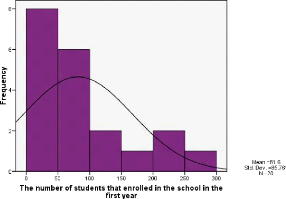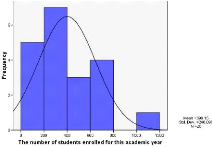4.4 Have these schools suffered from the government's
introduction of 'Free Primary Education (2003)' in terms of enrolment?
This section seeks to investigate the impact that Free Primary
Education has had on the enrolment of pupils in private schools of Kibera since
2003. Free Primary Education (FPE) was introduced in Kenya in the year 2003 by
the Government aided by International development partners. This initiative was
fulfilled by the government as part of the NARC's (National Rainbow Coalition)
election pledge in the general campaign of the year 2002. It set
to abolish fees and levies in the cost of basic education and
to offer greater opportunity to the population to have access to free
educational training.
As part of this research, it was decided to carry out an
investigation on the enrolment number of pupils in the private schools before
and after 2003. The results show that many schools in Kibera are growing
increasingly in terms of pupils' enrolments. Some of these schools like
Dagoretti (school A) started in 1999 with a total of 45 pupils and this were
able to enrol up to 500 pupils. Another typical example is the Amaf School
started their activities in 2003, the year of the introduction of FPE with a
total of 15 pupils and which for this academic year have enrolled 600
pupils.
The general view as the figures below present is that the
private schools in the slum of Kibera seem to be doing relatively well in terms
of their pupil numbers despite the huge national campaign for Free Primary
Education. Therefore even though there is `free' government education on the
outskirts of Kibera, parents still choose to pay fees in private school.
Therefore if there is a rejection of the government system this needs to be
investigated. There seem to be several reasons for this highlighted by this
research. As stated earlier, the 11 pupils out of the 25 in our research who
declared have been in public schools before attribute this failure to meet its
objectives by many factors. The quality of teaching, teacher's attention, and
congestion in the classrooms are for instance some of the key arguments that
brought back these pupils to the private schools in Kibera. To sum up, it would
seem that this research shows that even after the introduction of free primary
education in 2003 some parents still prefer to pay to send their children to
private schools. On the contrary, the figures from this study show an increase
in pupils' enrolments after the year 2003. In fact, one could assume that the
private educational system in Kibera is playing a leading role in providing
education to the population despite charging fees. Their cost however is very
limited and extremely
competitive if compared to the cost that are charged for
uniforms, books, parents association and many others in government schools,
supposedly free.
Figure 10: First year Enrolment


Figure 11: Current enrolments


4.5What is the satisfaction level of entrepreneur's
investments as perceived by pupils and teachers?
One of the most important issues arising in any competitive
business is the satisfaction level expressed by the recipients of a given
product. Back to the field of education, all the people who part- take to the
functioning of the business, the investor himself excluded, are the target
people that can make a fundamental assessment of this satisfaction. For scale
purposes we had chosen to gather data from the pupils who are the direct target
audience for which the product is designed and delivered and the teachers whom
the investors use in selling the product to the latter. The findings will
therefore help to ascertain what is most appreciated and what is less desirable
from pupils and teachers points of view.
| 

